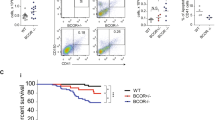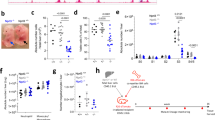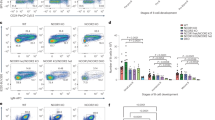Abstract
Co-repressor N-CoR (nuclear receptor co-repressor) has important roles in different biological processes, including proliferation, differentiation and development. Mutant mice lacking N-CoR are embryonically lethal and appear to die from anemia owing to defects in definitive erythropoiesis. However, the underlying molecular mechanisms of N-CoR-mediated erythroid differentiation are largely unknown. Using the human erythroleukemic K562 cell line, which can be chemically induced to differentiate into either erythroid or megakaryocytic lineages depending on the inducers used, we have investigated the role of N-CoR in erythroid differentiation. We show that knockdown of N-CoR either transiently (siRNA) or permanently (shRNA) impairs the cytosine arabinoside (Ara-C)- but not hemin-induced erythroid differentiation of K562 cells. RT-PCR analysis reveals that N-CoR is required for induction by Ara-C of 5-aminolevulinate synthase (ALA-S2), a key enzyme involved in heme biosynthesis. Furthermore, the amount of N-CoR proteins increases significantly during Ara-C-induced K562 differentiation, apparently through a post-transcriptional mechanism. Consistent with the data from N-CoR-null mice, N-CoR is not required for the differentiation of K562 cells into megakaryocytic lineages, induced by phorbol 12-myristate 13-acetate. Thus, our in vitro study confirms a role for N-CoR in erythroid differentiation and reveals for the first time that N-CoR is required for the induction of a key enzyme involved in heme synthesis.
Similar content being viewed by others
Log in or create a free account to read this content
Gain free access to this article, as well as selected content from this journal and more on nature.com
or
References
Jepsen K, Rosenfeld MG . Biological roles and mechanistic actions of co-repressor complexes. J Cell Sci 2002; 115:689–698.
Levine M, Tjian R . Transcription regulation and animal diversity. Nature 2003; 424:147–151.
Horlein AJ, Naar AM, Heinzel T, et al. Ligand-independent repression by the thyroid hormone receptor mediated by a nuclear receptor co-repressor. Nature 1995; 377:397–404.
Chen JD, Evans RM . A transcriptional co-repressor that interacts with nuclear hormone receptors. Nature 1995; 377:454–457.
Jepsen K, Hermanson O, Onami TM, et al. Combinatorial roles of the nuclear receptor corepressor in transcription and development. Cell 2000; 102:753–763.
Dhordain P, Albagli O, Lin RJ, et al. Corepressor SMRT binds the BTB/POZ repressing domain of the LAZ3/BCL6 oncoprotein. Proc Natl Acad Sci USA 1997; 94:10762–10767.
Kao HY, Ordentlich P, Koyano-Nakagawa N, et al. A histone deacetylase corepressor complex regulates the Notch signal transduction pathway. Genes Dev 1998; 12:2269–2277.
Yoon HG, Chan DW, Reynolds AB, et al. N-CoR mediates DNA methylation-dependent repression through a methyl CpG binding protein Kaiso. Mol Cell 2003; 12:723–734.
Tomita A, Buchholz DR, Shi YB . Recruitment of N-CoR/SMRT-TBLR1 corepressor complex by unliganded thyroid hormone receptor for gene repression during frog development. Mol Cell Biol 2004; 24:3337–3346.
Rosenfeld MG, Lunyak VV, Glass CK . Sensors and signals: a coactivator/corepressor/epigenetic code for integrating signal-dependent programs of transcriptional response. Genes Dev 2006; 20:1405–1428.
Lozzio CB, Lozzio BB . Human chronic myelogenous leukemia cell-line with positive Philadelphia chromosome. Blood 1975; 45:321–334.
Rutherford TR, Clegg JB, Weatherall DJ . K562 human leukaemic cells synthesise embryonic haemoglobin in response to haemin. Nature 1979; 280:164–165.
Housset M, Daniel MT, Degos L . Small doses of ARA-C in the treatment of acute myeloid leukaemia: differentiation of myeloid leukaemia cells? Br J Haematol 1982; 51:125–129.
Watanabe T, Mitchell T, Sariban E, et al. Effects of 1-beta-D-arabinofuranosylcytosine and phorbol ester on differentiation of human K562 erythroleukemia cells. Mol Pharmacol 1985; 27:683–688.
del Senno L, Conconi F, Barbieri R, et al. Human leukemic K562 cells: differential effects of 5-azacytidine on DNA methylation of epsilon-, gamma-globin and 7SL RNA genes. Boll Soc Ital Biol Sper 1984; 60:1613–1619.
Fibach E, Kollia P, Schechter AN, et al. Hemin-induced acceleration of hemoglobin production in immature cultured erythroid cells: preferential enhancement of fetal hemoglobin. Blood 1995; 85:2967–2974.
Takagaki K, Katsuma S, Horio T, et al. cDNA microarray analysis of altered gene expression in Ara-C-treated leukemia cells. Biochem Biophys Res Commun 2003; 309:351–358.
Kufe DW, Major PP, Egan EM, Beardsley GP . Correlation of cytotoxicity with incorporation of ara-C into DNA. J Biol Chem 1980; 255:8997–8900.
Kufe DW, Major PP . Studies on the mechanism of action of cytosine arabinoside. Med Pediatr Oncol 1982; 10 Suppl 1:49–67.
Zhang D, Yoon HG, Wong J . JMJD2A is a novel N-CoR-interacting protein and is involved in repression of the human transcription factor achaete scute-like homologue 2 (ASCL2/Hash2). Mol Cell Biol 2005; 25:6404–6414.
Ueki N, Zhang L, Hayman MJ . Ski negatively regulates erythroid differentiation through its interaction with GATA1. Mol Cell Biol 2004; 24:10118–10125.
Woessmann W, Zwanzger D, Borkhardt A . ERK signaling pathway is differentially involved in erythroid differentiation of K562 cells depending on time and the inducing agent. Cell Biol Int 2004; 28:403–410.
Kaiho S, Mizuno K . Sensitive assay systems for detection of hemoglobin with 2,7-diaminofluorene: histochemistry and colorimetry for erythrodifferentiation. Anal Biochem 1985; 149:117–120.
Ponka P . Cell biology of heme. Am J Med Sci 1999; 318:241–256.
Taketani S, Furukawa T, Furuyama K . Expression of coproporphyrinogen oxidase and synthesis of hemoglobin in human erythroleukemia K562 cells. Eur J Biochem 2001; 268:1705–1711.
Nagai T, Harigae H, Furuyama K, et al. 5-Aminolevulinate synthase expression and hemoglobin synthesis in a human myelogenous leukemia cell line. J Biochem (Tokyo) 1997; 121:487–495.
Zoller H, Decristoforo C, Weiss G . Erythroid 5-aminolevulinate synthase, ferrochelatase and DMT1 expression in erythroid progenitors: differential pathways for erythropoietin and iron-dependent regulation. Br J Haematol 2002; 118:619–626.
Chenais B, Molle I, Trentesaux C, et al. Time-course of butyric acid-induced differentiation in human K562 leukemic cell line: rapid increase in gamma-globin, porphobilinogen deaminase and NF-E2 mRNA levels. Leukemia 1997; 11:1575–1579.
McDonald TP, Sullivan PS . Megakaryocytic and erythrocytic cell lines share a common precursor cell. Exp Hematol 1993; 21:1316–1320.
Reading CL, Hickey CM, Yong WB . Analysis of cell surface glycoprotein changes related to hematopoietic differentiation. J Cell Biochem 1988; 37:21–36.
Butler TM, Ziemiecki A, Friis RR . Megakaryocytic differentiation of K562 cells is associated with changes in the cytoskeletal organization and the pattern of chromatographically distinct forms of phosphotyrosyl-specific protein phosphatases. Cancer Res 1990; 50:6323–6329.
Alitalo R . Induced differentiation of K562 leukemia cells: a model for studies of gene expression in early megakaryoblasts. Leuk Res 1990; 14:501–514.
Tahara T, Sun J, Nakanishi K, et al. Heme positively regulates the expression of beta-globin at the locus control region via the transcriptional factor Bach1 in erythroid cells. J Biol Chem 2004; 279:5480–5487.
Tahara T, Sun J, Igarashi K, et al. Heme-dependent up-regulation of the alpha-globin gene expression by transcriptional repressor Bach1 in erythroid cells. Biochem Biophys Res Commun 2004; 324:77–85.
Han AP, Fleming MD, Chen JJ . Heme-regulated eIF2alpha kinase modifies the phenotypic severity of murine models of erythropoietic protoporphyria and beta-thalassemia. J Clin Invest 2005; 115:1562–1570.
Park EJ, Schroen DJ, Yang M, et al. SMRTe, a silencing mediator for retinoid and thyroid hormone receptors-extended isoform that is more related to the nuclear receptor corepressor. Proceedings of the National Academy of Sciences of the United States of America 1999; 96:3519–3524.
Ordentlich P, Downes M, Xie W, et al. Unique forms of human and mouse nuclear receptor corepressor SMRT. Proceedings of the National Academy of Sciences of the United States of America 1999; 96:2639–2644.
Guenther MG, Lane WS, Fischle W, et al. A core SMRT corepressor complex containing HDAC3 and TBL1, a WD40-repeat protein linked to deafness. Genes Dev 2000; 14:1048–1057.
Li J, Wang J, Nawaz Z, et al. Both corepressor proteins SMRT and N-CoR exist in large protein complexes containing HDAC3. EMBO J 2000; 19:4342–4350.
Zhang J, Kalkum M, Chait BT, et al. The N-CoR-HDAC3 nuclear receptor corepressor complex inhibits the JNK pathway through the integral subunit GPS2. Mol Cell 2002; 9:611–623.
Yoon HG, Chan DW, Huang ZQ, et al. Purification and functional characterization of the human N-CoR complex: the roles of HDAC3, TBL1 and TBLR1. EMBO J 2003; 22:1336–1346.
Benezra R, Davis RL, Lockshon D, et al. The protein Id: a negative regulator of helix-loop-helix DNA binding proteins. Cell 1990; 61:49–59.
Lister J, Forrester WC, Baron MH . Inhibition of an erythroid differentiation switch by the helix-loop-helix protein Id1. J Biol Chem 1995; 270:17939–17946.
Cantor AB, Orkin SH . Transcriptional regulation of erythropoiesis: an affair involving multiple partners. Oncogene 2002; 21:3368–3376.
Lecuyer E, Hoang T . SCL: from the origin of hematopoiesis to stem cells and leukemia. Exp Hematol 2004; 32:11–24.
Ohneda K, Yamamoto M . Roles of hematopoietic transcription factors GATA-1 and GATA-2 in the development of red blood cell lineage. Acta Haematol 2002; 108:237–245.
Tsai FY, Orkin SH . Transcription factor GATA-2 is required for proliferation/survival of early hematopoietic cells and mast cell formation, but not for erythroid and myeloid terminal differentiation. Blood 1997; 89:3636–3643.
Fujiwara Y, Chang AN, Williams AM, et al. Functional overlap of GATA-1 and GATA-2 in primitive hematopoietic development. Blood 2004; 103:583–585.
Pevny L, Lin CS, D'Agati V, et al. Development of hematopoietic cells lacking transcription factor GATA-1. Development 1995; 121:163–172.
Oosterwegel M, Timmerman J, Leiden J, et al. Expression of GATA-3 during lymphocyte differentiation and mouse embryogenesis. Dev Immunol 1992; 3:1–11.
Cox TC, Bawden MJ, Martin A, et al. Human erythroid 5-aminolevulinate synthase: promoter analysis and identification of an iron-responsive element in the mRNA. EMBO J 1991; 10:1891–1902.
Acknowledgements
We thank Dr Chan (Department of Pharmacology, Baylor College of Medicine) for providing K562 cells and Dr Ho-Geun Yoon for discussion. This work was supported by the NIH Grant DK58679 to J Wong.
Author information
Authors and Affiliations
Corresponding author
Rights and permissions
About this article
Cite this article
Zhang, D., Cho, E. & Wong, J. A critical role for the co-repressor N-CoR in erythroid differentiation and heme synthesis. Cell Res 17, 804–814 (2007). https://doi.org/10.1038/cr.2007.72
Received:
Revised:
Accepted:
Published:
Issue date:
DOI: https://doi.org/10.1038/cr.2007.72
Keywords
This article is cited by
-
Clostridium perfringens α-toxin impairs erythropoiesis by inhibition of erythroid differentiation
Scientific Reports (2017)



